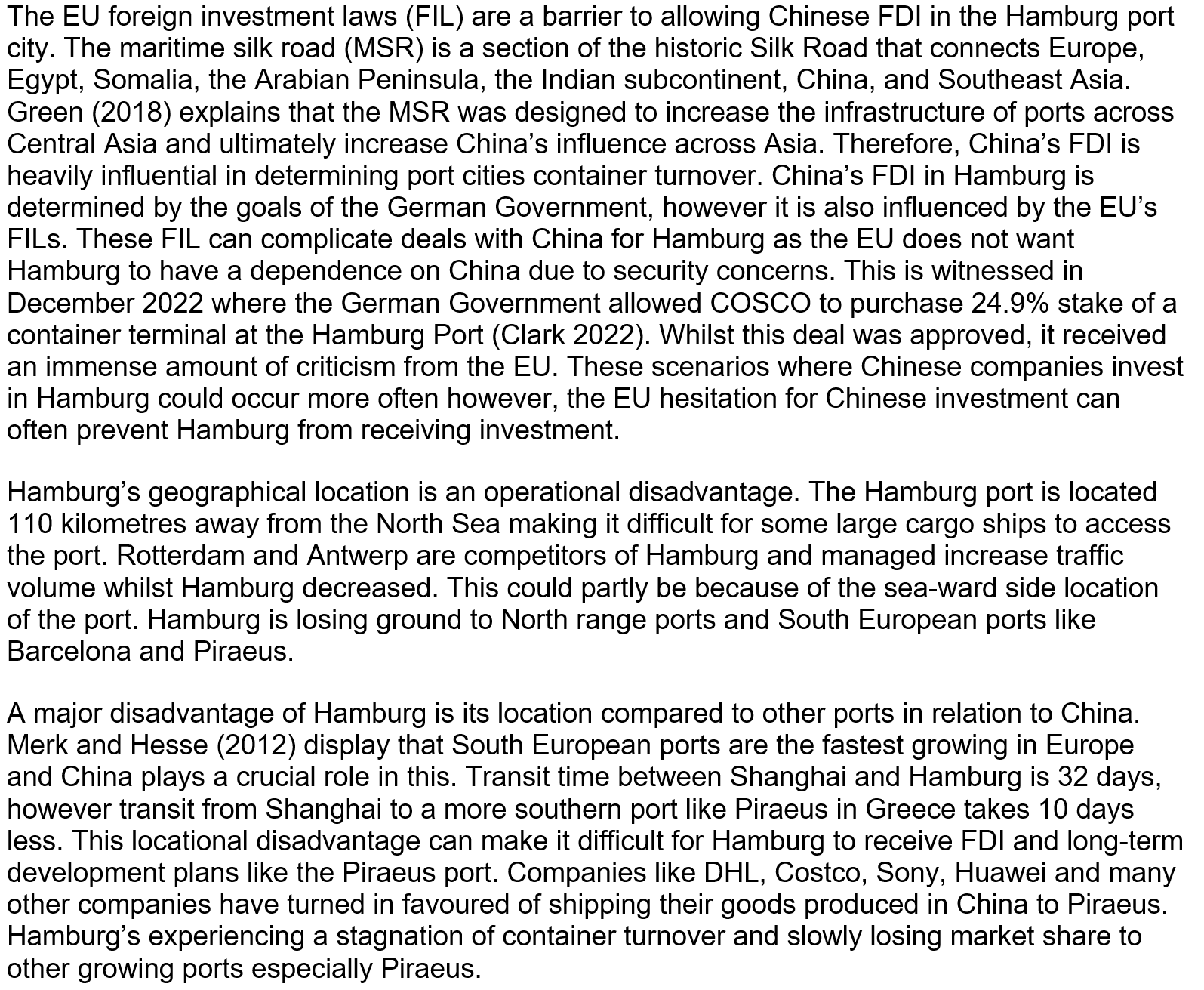Answered step by step
Verified Expert Solution
Question
1 Approved Answer
What are the solutions and strategies the Hamburg Port City can use to solve the challenges in the below screenshot.. Points to take in to
What are the solutions and strategies the Hamburg Port City can use to solve the challenges in the below screenshot..
Points to take in to consideration are:
1) Which FILs are making it difficult for Hamburg and then provide an alternative law that intends to do the same thing but less restricted to allow for more leniency.
2) How can Hamburg Port City improve turnaround times and attract more ships.
3) How can Hamburg Port City make efforts to accommodate megaships.

The EU foreign investment laws (FIL) are a barrier to allowing Chinese FDI in the Hamburg port city. The maritime silk road (MSR) is a section of the historic Silk Road that connects Europe, Egypt, Somalia, the Arabian Peninsula, the Indian subcontinent, China, and Southeast Asia. Green (2018) explains that the MSR was designed to increase the infrastructure of ports across Central Asia and ultimately increase China's influence across Asia. Therefore, China's FDI is heavily influential in determining port cities container turnover. China's FDI in Hamburg is determined by the goals of the German Government, however it is also influenced by the EU's FILs. These FIL can complicate deals with China for Hamburg as the EU does not want Hamburg to have a dependence on China due to security concerns. This is witnessed in December 2022 where the German Government allowed COSCO to purchase 24.9% stake of a container terminal at the Hamburg Port (Clark 2022). Whilst this deal was approved, it received an immense amount of criticism from the EU. These scenarios where Chinese companies invest in Hamburg could occur more often however, the EU hesitation for Chinese investment can often prevent Hamburg from receiving investment. Hamburg's geographical location is an operational disadvantage. The Hamburg port is located 110 kilometres away from the North Sea making it difficult for some large cargo ships to access the port. Rotterdam and Antwerp are competitors of Hamburg and managed increase traffic volume whilst Hamburg decreased. This could partly be because of the sea-ward side location of the port. Hamburg is losing ground to North range ports and South European ports like Barcelona and Piraeus. A major disadvantage of Hamburg is its location compared to other ports in relation to China. Merk and Hesse (2012) display that South European ports are the fastest growing in Europe and China plays a crucial role in this. Transit time between Shanghai and Hamburg is 32 days, however transit from Shanghai to a more southern port like Piraeus in Greece takes 10 days less. This locational disadvantage can make it difficult for Hamburg to receive FDI and long-term development plans like the Piraeus port. Companies like DHL, Costco, Sony, Huawei and many other companies have turned in favoured of shipping their goods produced in China to Piraeus. Hamburg's experiencing a stagnation of container turnover and slowly losing market share to other growing ports especially Piraeus.
Step by Step Solution
There are 3 Steps involved in it
Step: 1
Answer 1 Overcoming EU Foreign Investment Laws FILs Challenge EU FILs restrict Chinese Foreign Direct Investment FDI in the Hamburg port city due to s...
Get Instant Access to Expert-Tailored Solutions
See step-by-step solutions with expert insights and AI powered tools for academic success
Step: 2

Step: 3

Ace Your Homework with AI
Get the answers you need in no time with our AI-driven, step-by-step assistance
Get Started


